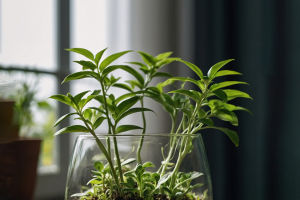
Looking to improve the air quality in your home? We've got you covered! Not only do air-purifying plants add a fresh touch to your space, but they also help clean the air by removing harmful pollutants.
While proper ventilation is key, bringing the right houseplants into your home can support a cleaner and healthier indoor environment.
As modern homes become more sealed to retain heat, they also lack the natural air flow that keeps indoor spaces ventilated. With that in mind, we should consider other ways to enhance indoor air quality, and adding houseplants is a great place to start.
Why is Air Quality Important?
We all know that good air quality is crucial for our health, but what does it really mean? Air quality is determined by levels of carbon dioxide, carbon monoxide, nitrogen oxide, and volatile organic compounds (VOCs). When these pollutants accumulate, they can lead to respiratory issues and exacerbate conditions like asthma. Improving air quality can help reduce these risks and make your home a more comfortable, breathable space.
How Plants Help Improve Air Quality
Houseplants have a natural ability to absorb pollutants through their leaves and roots. David Domoney, a horticulturist and expert, explains that some plants can effectively filter harmful compounds and release clean oxygen. Plants like these can help lower carbon dioxide levels, increase humidity, and reduce airborne pollutants. While having a plant or two might not dramatically change your air quality on its own, filling your space with greenery can certainly support the process.
Research shows that certain plants can remove VOCs like benzene and formaldehyde, which are found in cleaning products, paints, and even furniture. This process, known as phytoremediation, can significantly improve the overall quality of indoor air. Plus, plants increase humidity through transpiration, which can also benefit respiratory health.
Which Plants Are the Best for Air Purification?
Here are some of the best air-purifying plants that will not only improve your home's air quality but also make your space look beautiful.
1. Florist's Chrysanthemum
Known for its vibrant blooms, the Florist's Chrysanthemum can thrive indoors and help remove toxins like benzene and formaldehyde. It does best in cool, well-lit spots and needs regular watering. However, keep in mind that the leaves are toxic to pets.
2. Lady Palm
The Lady Palm is a perfect option for those with limited space. It is effective at removing ammonia and formaldehyde from the air and thrives in bright, indirect sunlight. It's easy to care for, and its elegant appearance makes it a great addition to any room.
3. Peace Lily
With its graceful white blooms, the Peace Lily is not only aesthetically pleasing but also effective at purifying the air. It absorbs toxins like benzene and trichloroethylene, making it a top choice for improving air quality in your home. Peace Lilies thrive in low light conditions, making them a great option for darker rooms.
4. English Ivy
English Ivy's trailing vines make it a versatile choice for any space, especially for those looking for an attractive hanging plant. This plant excels in removing pollutants and can thrive in a variety of conditions, including the kitchen or bathroom.
5. Snake Plant
The Snake Plant is a low-maintenance plant that converts CO2 into oxygen at night, making it a great bedroom plant. It can also remove harmful chemicals like xylene and trichloroethylene, making it a wonderful addition to any room.
6. Bamboo Palm
This plant adds a tropical touch to your home and effectively removes benzene and trichloroethylene from the air. Bamboo Palms thrive in moderate light and are safe for pets, making them a great choice for households with animals.
7. Red-Edged Dracaena
The Red-Edged Dracaena is a stunning plant with spiky red-edged leaves. It's easy to care for and can remove harmful toxins like formaldehyde, benzene, and trichloroethylene. Be cautious, though, as it is toxic to pets.
8. Weeping Fig
Weeping Figs are beautiful, tall plants that can remove formaldehyde and xylene from the air. They're perfect for bright, indirect light and can thrive in a variety of room environments. However, they are toxic to pets, so keep them out of reach.
9. Barberton Daisy
Known for its bright, colorful blooms, the Barberton Daisy is a non-toxic option for homes with pets. It also helps to remove harmful toxins from the air and thrives in bright, direct light.
10. Aloe Vera
Aloe Vera is a popular succulent known for its soothing properties and air-purifying abilities. It removes VOCs like formaldehyde and benzene and is great for reducing excess humidity in the bathroom or kitchen.
Conclusion
Incorporating these air-purifying plants into your home can enhance both your physical and mental well-being. They can improve the quality of the air you breathe, reduce stress, and even help you sleep better. So why not introduce a few plants into your space and start reaping the benefits today? Your home—and your health—will thank you!


